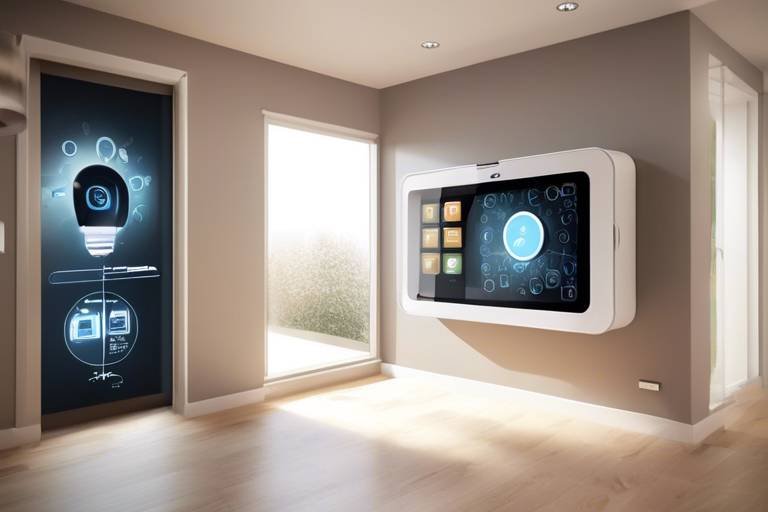Innovations in Smart Building Technologies
Welcome to the future of urban living, where smart building technologies are revolutionizing the way we interact with our environments. Imagine walking into a building that knows your preferences, adjusts the lighting to your liking, and optimizes energy use without you even lifting a finger. This is not just a dream; it's becoming a reality thanks to the latest advancements in technology. In this article, we will delve into the fascinating world of smart buildings, exploring innovations that are not only enhancing energy efficiency but also improving overall user experience and promoting sustainability.
As cities grow and populations increase, the need for efficient and sustainable building solutions has never been more critical. The integration of energy management systems, automated lighting, and building automation systems is paving the way for smarter, more responsive buildings. These technologies leverage real-time data to create environments that are not only comfortable but also environmentally friendly. The impact of these innovations extends beyond individual buildings; they contribute to the broader goal of sustainable urban living, reducing carbon footprints and enhancing the quality of life for all residents.
But what exactly does a smart building entail? At its core, a smart building is equipped with advanced systems that automate processes, optimize energy use, and enhance the user experience. This includes everything from smart HVAC systems that ensure optimal indoor air quality to user-centric interfaces that allow occupants to control their environment with ease. The beauty of these technologies lies in their ability to adapt and respond to the needs of the users, making every interaction seamless and intuitive.
In the following sections, we will explore several key innovations in smart building technologies, including energy management systems, automated lighting solutions, sustainable materials, and user-centric interfaces. Each of these elements plays a crucial role in creating buildings that are not only efficient but also enhance the quality of life for their occupants. So, buckle up as we take a closer look at how these innovations are shaping the future of urban living!
Energy management systems are crucial for optimizing energy consumption in smart buildings, utilizing real-time data to reduce waste and improve efficiency while lowering operational costs.
Automated lighting solutions enhance user comfort and energy efficiency by adjusting illumination based on occupancy and natural light levels, contributing to a more sustainable building environment.
Smart sensors play a vital role in automated lighting, detecting occupancy and ambient light to ensure optimal energy use while enhancing the user experience in various spaces.
Integrating smart sensors with IoT technology allows for seamless communication between devices, enabling more responsive lighting systems that adapt to real-time conditions and user preferences.
Smart lighting offers numerous benefits, including energy savings, improved safety, and enhanced ambiance, making it a key component of modern smart building design.
Building automation systems streamline operations by integrating various subsystems such as HVAC, security, and lighting, improving overall efficiency and user comfort.
The use of sustainable materials and design principles in smart buildings promotes environmental responsibility, reducing the carbon footprint while enhancing aesthetic appeal and functionality.
Achieving green certifications, such as LEED, demonstrates a building's commitment to sustainability, encouraging the adoption of eco-friendly practices and technologies in the construction and operation phases.
Smart HVAC systems optimize heating, ventilation, and air conditioning by utilizing data analytics and automation, ensuring optimal indoor air quality and energy efficiency throughout the building.
User-centric interfaces in smart buildings enhance the occupant experience by providing intuitive control over environmental settings, improving comfort, and fostering engagement with building systems.
Mobile applications empower users to monitor and control smart building features remotely, allowing for personalized adjustments and real-time feedback on energy consumption and comfort levels.
Implementing feedback mechanisms enables occupants to provide input on their experiences, helping building managers make informed decisions to improve functionality and user satisfaction.
- What are smart building technologies? Smart building technologies refer to systems and solutions that use advanced technology to enhance the efficiency, comfort, and sustainability of buildings.
- How do energy management systems work? Energy management systems monitor and optimize energy consumption in real-time, helping to reduce waste and operational costs.
- What is the role of IoT in smart buildings? IoT enables seamless communication between devices, allowing for integrated systems that respond to user needs and environmental conditions.
- How can I benefit from smart lighting solutions? Smart lighting solutions provide energy savings, improved safety, and enhanced ambiance, creating a more comfortable living or working environment.

Energy Management Systems
This article explores the latest advancements in smart building technologies, focusing on energy efficiency, automation, and enhanced user experience, while also discussing their impact on sustainability and urban living.
Energy management systems (EMS) are the backbone of modern smart buildings, acting as the brain that optimizes energy consumption and reduces waste. Imagine a conductor leading an orchestra, ensuring every instrument plays in harmony; that's what an EMS does for energy use. By leveraging real-time data, these systems can make instantaneous adjustments to energy consumption, which not only helps in lowering operational costs but also significantly reduces the carbon footprint of buildings.
At the heart of an effective EMS are advanced algorithms and analytics that monitor energy usage patterns. These systems gather data from various sources, such as smart meters and sensors, to provide insights into when and where energy is being consumed. For instance, during peak hours, the EMS can automatically adjust settings to minimize energy use without compromising comfort. This kind of proactive management is essential in today’s world, where energy efficiency is not just a goal but a necessity.
Moreover, implementing an EMS can lead to substantial savings. According to recent studies, buildings equipped with these systems can achieve energy savings of up to 30%. This is not just a win for the environment; it's a win for the wallet too! By reducing energy waste, building owners can redirect those funds towards other improvements or innovations.
One of the most compelling features of contemporary EMS is their ability to integrate with other smart building technologies. For example, when combined with automated lighting solutions and smart HVAC systems, the EMS can create a cohesive energy strategy that maximizes efficiency across all systems. This integration ensures that energy use is optimized throughout the day, adapting to real-time conditions and user behaviors.
To illustrate the impact of energy management systems, consider the following table:
| Feature | Benefit | Impact |
|---|---|---|
| Real-time Monitoring | Immediate insights into energy consumption | Reduction in energy waste by identifying inefficiencies |
| Automated Controls | Adjust systems based on usage patterns | Enhanced comfort while minimizing energy use |
| Data Analytics | Predictive maintenance and energy forecasting | Informed decision-making leading to long-term savings |
In summary, energy management systems are essential for optimizing energy consumption in smart buildings. They not only facilitate significant cost savings but also contribute to a more sustainable future. As technology continues to evolve, the capabilities of EMS will only expand, making them an indispensable tool for building owners and managers aiming to create efficient, eco-friendly environments.
- What is an Energy Management System?
An Energy Management System is a technology that monitors and optimizes energy consumption in buildings using real-time data and analytics.
- How can EMS reduce operational costs?
By identifying inefficiencies and adjusting energy use based on demand, EMS can lead to substantial savings on energy bills.
- Can EMS integrate with other smart technologies?
Yes, EMS can seamlessly integrate with systems like automated lighting and smart HVAC to optimize overall energy efficiency.

Automated Lighting Solutions
In today's fast-paced world, have emerged as a game-changer in the realm of smart building technologies. Imagine walking into a room, and the lights automatically adjust to your presence, creating an inviting atmosphere tailored just for you. This is not just a fantasy; it’s the reality of modern lighting systems that enhance user comfort and significantly boost energy efficiency. By utilizing advanced sensors and smart technology, these systems can intelligently respond to occupancy and natural light levels, ensuring that spaces are illuminated only when necessary. This leads to a remarkable reduction in energy waste, which is a win-win for both the environment and your wallet.
But how do these systems work? At the heart of automated lighting are smart sensors. These sensors are the unsung heroes, constantly monitoring the surrounding environment. They detect when a room is occupied or unoccupied and adjust the lighting accordingly. For instance, if you step into a conference room, the lights will brighten to a comfortable level, but if you leave, they will dim or turn off completely. This not only saves energy but also extends the lifespan of the lighting fixtures.
One of the most exciting aspects of automated lighting solutions is their integration with the Internet of Things (IoT). By connecting smart sensors with IoT technology, lighting systems can communicate seamlessly with other devices within the building. Imagine a scenario where your lighting system knows the weather outside; if it’s a sunny day, the lights can automatically dim to match the natural light pouring in through the windows. This level of responsiveness creates a more comfortable and energy-efficient environment, making your building not just smart, but truly intuitive.
Furthermore, the benefits of smart lighting extend beyond just energy savings. These systems contribute to improved safety and enhanced ambiance. For example, motion sensors can activate pathway lighting when someone approaches, ensuring visibility and security during nighttime hours. Additionally, with customizable settings, users can create different lighting scenes for various activities, from bright lights for a productive work session to softer hues for relaxation. The ability to adapt lighting to suit the mood or activity is a significant leap towards creating user-centric spaces.
The advantages of implementing automated lighting solutions in smart buildings are numerous. Here’s a quick overview:
- Energy Savings: Reduced electricity consumption leads to lower utility bills and a smaller carbon footprint.
- Improved Safety: Enhanced visibility in common areas reduces the risk of accidents.
- Enhanced Ambiance: Customizable lighting options create the perfect atmosphere for any occasion.
In conclusion, automated lighting solutions are not just about convenience; they represent a significant step towards a more sustainable and user-friendly future. By embracing these technologies, we can create environments that are not only efficient but also responsive to the needs of their occupants. As we continue to innovate and integrate smart technologies into our buildings, the potential for energy savings and enhanced living experiences is boundless.
Q1: How do automated lighting systems save energy?
A1: Automated lighting systems save energy by using sensors to detect occupancy and adjust lighting levels accordingly. Lights can turn off or dim when a room is unoccupied, significantly reducing energy waste.
Q2: Can automated lighting systems be controlled remotely?
A2: Yes! Many automated lighting solutions can be integrated with mobile applications, allowing users to control their lighting remotely and customize settings to their preferences.
Q3: Are automated lighting solutions expensive to install?
A3: While the initial installation cost may be higher than traditional lighting, the long-term energy savings and increased efficiency often offset these costs, making them a worthwhile investment.
Q4: Do automated lighting systems enhance security?
A4: Absolutely! Features like motion sensors can activate lights in pathways or entryways, improving visibility and safety, especially during nighttime.

Smart Sensors
Smart sensors are the unsung heroes of modern building automation, working tirelessly behind the scenes to create a seamless and efficient environment. Imagine walking into a room and having the lights turn on automatically, the temperature adjust to your preference, and even the blinds open to let in natural light. This is the magic of smart sensors, which use advanced technology to detect occupancy and ambient conditions, ensuring that energy is used only when necessary. These sensors not only enhance user comfort but also contribute significantly to energy savings, making them an essential component of any smart building.
At their core, smart sensors operate by gathering real-time data from their surroundings. For instance, occupancy sensors can determine whether a room is in use or vacant. When a space is unoccupied, the system can automatically dim the lights or adjust the HVAC settings to save energy. Similarly, ambient light sensors measure the amount of natural light entering a room, allowing artificial lighting to be adjusted accordingly. This dynamic interplay between sensors and building systems creates a responsive environment that adapts to the needs of its occupants.
Moreover, the integration of smart sensors with the Internet of Things (IoT) takes this functionality to the next level. By connecting sensors to a central network, building systems can communicate with each other, sharing data and responding in real-time. For example, if a person enters a conference room, the smart lighting system can automatically brighten the lights while the HVAC system adjusts to maintain a comfortable temperature. This level of automation not only enhances user experience but also significantly reduces energy consumption.
Here are some key benefits of smart sensors:
- Energy Efficiency: By optimizing energy use based on real-time data, smart sensors help reduce energy waste and lower utility bills.
- User Comfort: They create a more comfortable environment by adjusting settings to meet the preferences of occupants.
- Enhanced Safety: Smart sensors can improve safety by ensuring that areas are well-lit when occupied and can alert security systems in case of unauthorized access.
In conclusion, smart sensors play a pivotal role in the evolution of smart buildings. Their ability to gather and respond to data in real-time not only enhances the user experience but also contributes to a more sustainable and efficient built environment. As technology continues to advance, we can expect these sensors to become even more sophisticated, further revolutionizing how we interact with our spaces.

Integration with IoT
The integration of smart sensors with the Internet of Things (IoT) is a game-changer for smart building technologies. Imagine a world where your building knows you better than you know yourself! With IoT, devices communicate seamlessly, creating an ecosystem that not only responds to your needs but anticipates them. This level of connectivity allows for real-time adjustments in lighting, heating, and ventilation, ensuring that your environment is always optimized for comfort and efficiency.
When smart sensors are connected to the IoT, they can collect and share data across various platforms. This means that if a room is unoccupied, the lighting can automatically dim, and the HVAC system can adjust, saving energy without sacrificing comfort. It's like having a personal assistant who manages your building's resources while you focus on more important tasks. The beauty of this integration lies in its ability to create a dynamic living space that evolves with the occupants' habits and preferences.
Moreover, the integration of IoT enhances security measures within smart buildings. Sensors can detect unusual activities and alert security systems in real-time, providing a safer environment for everyone. This interconnectedness not only improves user experience but also allows for comprehensive data analysis, helping building managers make informed decisions about resource allocation and maintenance schedules.
To illustrate the impact of IoT integration in smart buildings, consider the following table:
| Feature | Benefits |
|---|---|
| Real-Time Monitoring | Immediate adjustments to lighting and HVAC based on occupancy. |
| Enhanced Security | Instant alerts for unusual activities, improving safety. |
| Data Analytics | Informed decision-making for energy management and maintenance. |
| User Customization | Personalized settings for lighting, temperature, and more. |
In essence, the integration of smart sensors with IoT is not just a technological advancement; it's a revolution in how we interact with our spaces. It transforms buildings into intelligent environments that adapt to our needs, making our lives easier and more efficient. As we continue to embrace these innovations, the future of urban living looks brighter than ever!
- What is IoT? The Internet of Things (IoT) refers to the network of interconnected devices that communicate and exchange data with each other, enhancing automation and efficiency.
- How does IoT benefit smart buildings? IoT allows for real-time monitoring and control of building systems, leading to improved energy efficiency, enhanced security, and a better user experience.
- Can IoT integration reduce operational costs? Yes, by optimizing energy usage and improving maintenance schedules through data analysis, IoT can significantly lower operational costs in smart buildings.
- Are smart buildings safe? Smart buildings equipped with IoT technology can enhance safety through real-time monitoring and automated alerts for unusual activities.

Benefits of Smart Lighting
Smart lighting is not just a trend; it's a revolution in how we illuminate our spaces. Imagine walking into a room, and the lights adjust automatically to your preferred brightness. This is just one of the many benefits that smart lighting systems bring to the table. By incorporating advanced technology, these systems offer a multitude of advantages that go beyond mere convenience.
First and foremost, energy savings are a significant benefit. Traditional lighting systems often waste energy by remaining on when not needed. In contrast, smart lighting utilizes occupancy sensors to detect when a room is in use, ensuring that lights are only on when necessary. This can lead to substantial reductions in energy consumption and, consequently, lower utility bills. In fact, studies suggest that smart lighting can reduce energy usage by up to 30% or more compared to conventional systems.
Another key advantage is improved safety. Well-lit environments deter criminal activity and enhance overall security. Smart lighting systems can be programmed to turn on at specific times, creating the illusion of occupancy when homeowners are away. Additionally, motion-activated lights can illuminate pathways, making it safer to navigate spaces at night. This is particularly beneficial for elderly individuals or those with mobility challenges.
Moreover, smart lighting contributes to a better ambiance. With adjustable color temperatures and brightness levels, users can create the perfect atmosphere for any occasion, whether it’s a cozy dinner party or a bright workspace. The ability to control lighting through mobile apps or voice commands adds a layer of personalization that enhances the user experience. Imagine hosting a movie night and dimming the lights with just a simple voice command!
In addition to these benefits, smart lighting systems are often integrated with other home automation technologies, creating a cohesive and efficient environment. For instance, when paired with smart thermostats, lighting can adjust based on the time of day, reducing energy waste even further. This integration not only enhances the functionality of each system but also promotes a sustainable lifestyle by minimizing the overall carbon footprint of the building.
To summarize, the benefits of smart lighting can be encapsulated in the following points:
- Energy Efficiency: Reduces energy consumption and lowers bills.
- Enhanced Safety: Deters crime and improves navigation at night.
- Improved Ambiance: Customizable settings for various occasions.
- Integration with Other Systems: Works seamlessly with other smart technologies.
- Sustainability: Supports eco-friendly practices and reduces carbon footprint.
In conclusion, the transition to smart lighting systems is not only about embracing technology; it's about enhancing our quality of life while being mindful of our planet. As we continue to innovate and integrate smart technologies into our daily lives, the benefits of smart lighting will undoubtedly play a crucial role in shaping the future of our living and working environments.
Q1: How does smart lighting save energy?
A1: Smart lighting saves energy by using occupancy sensors to turn lights on and off based on whether a room is in use, significantly reducing waste.
Q2: Can I control smart lighting remotely?
A2: Yes, most smart lighting systems come with mobile applications that allow you to control your lights from anywhere, providing convenience and flexibility.
Q3: Is smart lighting safe?
A3: Absolutely! Smart lighting enhances safety by illuminating pathways and can be programmed to simulate occupancy when you're away, deterring potential intruders.
Q4: What is the installation process for smart lighting?
A4: Installation varies by system, but many smart lighting solutions are designed for easy setup, often requiring only a few simple steps to connect to your Wi-Fi network and configure through an app.
Q5: Are smart lighting systems compatible with other smart home devices?
A5: Yes, most smart lighting systems can be integrated with other smart home devices, allowing for a comprehensive home automation experience.

Building Automation Systems
Building Automation Systems (BAS) have revolutionized the way we interact with our living and working environments. Imagine stepping into a building where the lights adjust automatically to your presence, the temperature is just right, and security systems are seamlessly integrated to provide safety without intrusion. This is not science fiction; it's the reality brought to life by BAS. These systems are designed to streamline operations by integrating various subsystems such as heating, ventilation, and air conditioning (HVAC), security, and lighting into a single cohesive framework.
At the heart of BAS lies the ability to monitor and control building systems in real-time. This means that energy consumption can be optimized based on current occupancy and usage patterns, leading to significant cost savings and enhanced user comfort. For instance, if a conference room is empty, the system can automatically adjust the HVAC settings and turn off the lights, preventing unnecessary energy waste. This level of automation not only reduces operational costs but also contributes to a more sustainable future.
Furthermore, the integration of BAS with smart technologies enables building managers to access valuable data analytics. These insights can help identify trends in energy usage or areas needing maintenance, allowing for proactive measures to be taken before issues escalate. This predictive approach not only enhances building performance but also extends the lifespan of equipment, leading to lower maintenance costs over time.
To illustrate the benefits of Building Automation Systems, consider the following table that outlines key features and advantages:
| Feature | Advantage |
|---|---|
| Real-time Monitoring | Allows immediate adjustments to optimize performance and comfort. |
| Energy Management | Reduces costs by minimizing energy waste and optimizing usage. |
| Integrated Security | Enhances safety through seamless communication between security systems. |
| Data Analytics | Provides insights for informed decision-making and proactive maintenance. |
In addition to energy savings and operational efficiency, BAS significantly enhances the overall occupant experience. Users can enjoy personalized control over their environment, adjusting settings from mobile applications or user-friendly interfaces. This level of control fosters a sense of ownership and satisfaction among occupants, making buildings not only places to work or live but also spaces where individuals feel comfortable and engaged.
As urban areas continue to grow, the importance of efficient building management systems cannot be overstated. With the rise of smart cities and increasing environmental concerns, investing in Building Automation Systems is not just a trend, but a necessity for the future of sustainable urban living. By embracing these technologies, we can create smarter, more responsive buildings that cater to the needs of their occupants while contributing positively to the environment.
- What are Building Automation Systems? Building Automation Systems are integrated systems that manage and control a building's various subsystems, such as HVAC, lighting, and security, to enhance efficiency and comfort.
- How do BAS contribute to energy savings? BAS optimize energy usage by automatically adjusting settings based on occupancy and real-time data, minimizing waste and reducing operational costs.
- Can BAS improve occupant comfort? Yes, they provide users with personalized control over their environment, leading to increased satisfaction and comfort.
- Are BAS difficult to implement? While the implementation process can vary depending on the building and technology, many modern systems are designed for easy integration and user-friendly operation.

Sustainable Materials and Design
Sustainable materials and design are at the forefront of modern architecture, reshaping how we think about the spaces we inhabit. As urban populations grow and environmental concerns escalate, the need for buildings that are not only functional but also environmentally responsible becomes increasingly critical. Imagine a world where your office building not only houses your work but also actively contributes to the health of the planet. This is the promise of integrating sustainability into building materials and design principles.
Using sustainable materials means selecting resources that are renewable, recyclable, and have a minimal environmental impact. For instance, bamboo is a fantastic alternative to traditional timber, as it grows rapidly and can be harvested without damaging the ecosystem. Similarly, recycled steel and glass not only reduce waste but also offer durability and aesthetic appeal. By prioritizing these materials, architects and builders can create structures that are both beautiful and sustainable. The benefits of incorporating sustainable materials extend beyond environmental impact; they also enhance the building's performance and longevity.
Design principles play a crucial role in achieving sustainability. For example, passive solar design maximizes natural light and heat from the sun, reducing the need for artificial lighting and heating. This approach not only lowers energy bills but also creates a more pleasant indoor environment. Furthermore, green roofs and walls can provide insulation, reduce rainwater runoff, and even promote biodiversity in urban areas. These design strategies are not just about aesthetics; they are about creating a harmonious relationship between the built environment and nature.
Moreover, achieving green certifications, such as LEED (Leadership in Energy and Environmental Design), serves as a benchmark for sustainable building practices. These certifications encourage the adoption of eco-friendly technologies and materials during both construction and operation phases. Buildings that achieve such certifications often experience higher occupancy rates and increased property values, as tenants and buyers are becoming more aware of the benefits of sustainability.
Incorporating sustainable materials and design is not just a trend; it's a necessity for our future. As we continue to face challenges like climate change and urbanization, embracing these practices will ensure that our buildings contribute positively to the environment. It's about creating a legacy of responsibility and resilience for future generations. So, whether you're an architect, builder, or simply someone interested in how we can make our world a better place, understanding the importance of sustainable materials and design is essential.
- What are sustainable materials? Sustainable materials are resources that are renewable, recyclable, and have minimal environmental impact, such as bamboo, recycled steel, and reclaimed wood.
- Why is sustainable design important? Sustainable design reduces environmental impact, enhances energy efficiency, and creates healthier living spaces, contributing to a better quality of life.
- What is LEED certification? LEED certification is a globally recognized symbol of sustainability achievement, indicating that a building meets strict environmental standards.
- How can I make my home more sustainable? You can use sustainable materials, implement energy-efficient appliances, and consider passive solar design to reduce your home's environmental footprint.

Green Certifications
In today's world, where climate change and environmental degradation are pressing issues, have become a beacon of hope for sustainable building practices. These certifications serve as a testament to a building's commitment to sustainability, promoting eco-friendly practices throughout its lifecycle—from construction to operation. Achieving such certifications not only enhances a building's reputation but also plays a crucial role in attracting environmentally conscious tenants and investors.
Among the most recognized green certifications is the LEED (Leadership in Energy and Environmental Design) certification, developed by the U.S. Green Building Council. LEED evaluates buildings based on several criteria, including energy efficiency, water usage, indoor environmental quality, and the use of sustainable materials. Buildings that achieve LEED certification often enjoy reduced operational costs, improved occupant health, and increased marketability. It's like wearing a badge of honor in the green building community!
But LEED isn't the only player in the game. Other notable certifications include:
- BREEAM (Building Research Establishment Environmental Assessment Method) - A UK-based certification focusing on sustainability across the lifecycle of a building.
- WELL Building Standard - This certification emphasizes the health and well-being of building occupants through features that promote physical and mental well-being.
- Green Globes - An American certification that offers a flexible approach to sustainability, allowing for a more tailored evaluation process.
These certifications not only signify a commitment to sustainability but also encourage the adoption of innovative technologies and practices. For instance, buildings that pursue green certifications often incorporate renewable energy sources, such as solar panels and wind turbines, significantly reducing their carbon footprint. Moreover, they frequently utilize materials that are recycled or sourced sustainably, further minimizing environmental impact.
In addition to environmental benefits, green certifications can lead to substantial financial savings. Buildings that are certified often experience lower utility bills due to their energy-efficient designs and systems. This translates to a quicker return on investment for building owners and operators. It's a win-win situation where both the planet and the pocketbook benefit.
As cities continue to grow and urban living becomes more prevalent, the importance of green certifications will only increase. They not only help in mitigating the effects of urbanization but also foster a sense of community and responsibility among occupants. By choosing to live or work in a certified green building, individuals are making a conscious choice to support sustainability.
In conclusion, green certifications are more than just a trend; they represent a fundamental shift towards a more sustainable future. As more buildings achieve these certifications, we can look forward to a world where urban living harmonizes with environmental stewardship, paving the way for healthier communities and a thriving planet.
Q1: What are the main benefits of obtaining a green certification for a building?
A1: The main benefits include reduced operational costs, improved occupant health and comfort, increased property value, and enhanced marketability. Green certifications also demonstrate a commitment to sustainability, which can attract environmentally conscious tenants and investors.
Q2: How can a building achieve LEED certification?
A2: To achieve LEED certification, a building must meet specific criteria across various categories such as energy efficiency, water usage, and indoor environmental quality. The building must undergo a thorough evaluation process, and documentation must be submitted to the U.S. Green Building Council for review.
Q3: Are there different types of green certifications?
A3: Yes, there are several types of green certifications, including LEED, BREEAM, WELL Building Standard, and Green Globes. Each certification has its own criteria and focus areas, allowing building owners to choose the one that best fits their sustainability goals.
Q4: Do green certifications impact the resale value of a building?
A4: Yes, buildings with green certifications often have higher resale values due to their energy efficiency, reduced operational costs, and appeal to environmentally conscious buyers.

Smart HVAC Systems
In the realm of smart building technologies, are revolutionizing how we think about heating, ventilation, and air conditioning. Imagine a world where your indoor environment adjusts itself automatically based on your preferences and the current weather conditions outside. With the integration of advanced data analytics and automation, these systems not only ensure optimal indoor air quality but also maximize energy efficiency throughout the building. This means you can enjoy a comfortable atmosphere without feeling the pinch in your wallet when the utility bill arrives.
So how do these systems work? At their core, smart HVAC systems utilize a network of sensors and controllers that monitor various factors such as temperature, humidity, and occupancy levels. This real-time data allows the system to make adjustments on-the-fly, ensuring that energy is not wasted heating or cooling empty rooms. For example, if you leave your office for a meeting, the HVAC system can detect your absence and reduce energy output in that space without compromising comfort for those still present.
Moreover, many smart HVAC systems are designed to learn from user behavior over time. They can analyze patterns in your daily routine and adjust settings accordingly. Picture this: you typically arrive home from work around 6 PM. A smart HVAC system can gradually start cooling or heating your home in advance, so you walk into a perfectly comfortable space right when you need it. This not only enhances your comfort but also contributes to significant energy savings, reducing the overall carbon footprint of the building.
Another exciting aspect of smart HVAC systems is their ability to integrate with other smart building technologies. For instance, when combined with automated lighting solutions, these systems can create a holistic approach to energy management. If a room is unoccupied, both the lights and HVAC can be adjusted to conserve energy. This integration creates a seamless user experience and promotes a more sustainable building environment.
To illustrate the impact of smart HVAC systems, consider the following table that highlights their key benefits:
| Benefit | Description |
|---|---|
| Energy Efficiency | Reduces energy consumption through real-time adjustments based on occupancy and environmental conditions. |
| Enhanced Comfort | Maintains optimal indoor air quality and temperature, tailored to user preferences. |
| Cost Savings | Lowers utility bills by minimizing energy waste and optimizing system performance. |
| Environmental Impact | Contributes to sustainability efforts by reducing the carbon footprint of the building. |
In conclusion, smart HVAC systems are more than just a trend; they are a vital component of modern smart buildings. By leveraging technology to create a more responsive and efficient environment, these systems not only enhance user comfort but also play a crucial role in promoting sustainability. As we continue to embrace innovations in building technologies, the future looks bright for energy-efficient living.
- What is a smart HVAC system? A smart HVAC system uses advanced technology to automatically adjust heating and cooling based on real-time data and user preferences.
- How do smart HVAC systems save energy? They optimize energy use by monitoring occupancy and environmental conditions, ensuring that energy is not wasted in unoccupied spaces.
- Can I control my smart HVAC system remotely? Yes, many smart HVAC systems come with mobile applications that allow you to monitor and control settings from anywhere.
- Are smart HVAC systems expensive to install? While the initial investment may be higher, the long-term savings on energy bills often justify the cost.

User-Centric Interfaces
User-centric interfaces are revolutionizing the way occupants interact with smart buildings. Imagine walking into a space where you have the power to control your environment at your fingertips—this is the essence of user-centric design. These interfaces prioritize the needs and preferences of the users, making their experience not only more comfortable but also more engaging. With intuitive controls, occupants can easily adjust lighting, temperature, and even security settings, creating a personalized atmosphere that suits their lifestyle.
One of the standout features of user-centric interfaces is their ability to provide real-time feedback. This means that as users make adjustments, they can instantly see the impact of their changes. For instance, if you decide to lower the thermostat, you’ll see how that affects energy consumption right away. This immediate feedback loop encourages occupants to engage more with their environment, fostering a sense of ownership and responsibility towards energy usage.
Moreover, mobile applications play a pivotal role in enhancing user-centric interfaces. These apps allow users to control various aspects of the building remotely, which is a game-changer for convenience. Whether you're at home, at work, or on the go, you can monitor and adjust settings with just a few taps on your smartphone. This level of control not only improves comfort but also contributes to energy efficiency. Users can turn off lights or adjust the HVAC system when they’re not in the building, leading to significant energy savings.
To illustrate the impact of user-centric interfaces, consider the following table that highlights key features and their benefits:
| Feature | Benefit |
|---|---|
| Intuitive Controls | Easy navigation for users, reducing the learning curve. |
| Real-Time Feedback | Encourages responsible energy use and enhances user engagement. |
| Remote Access via Mobile Apps | Convenience and control from anywhere, improving user satisfaction. |
| Customizable Settings | Personalized environment enhances comfort and well-being. |
Additionally, feedback mechanisms are integral to the success of user-centric interfaces. By allowing occupants to provide input on their experiences, building managers can gather valuable insights. This feedback can lead to improvements in functionality, making the building not just a space to inhabit but a responsive environment that evolves with its users. Imagine being able to suggest a new feature or report an issue directly through your app—this level of interaction fosters a community atmosphere and enhances overall satisfaction.
In conclusion, user-centric interfaces are not just about technology; they’re about creating a harmonious relationship between occupants and their environments. As buildings become smarter, the focus on user experience will only grow, paving the way for more innovative solutions that prioritize comfort, efficiency, and sustainability.
- What are user-centric interfaces? User-centric interfaces are designs that prioritize the needs and preferences of users, allowing them to control their environment easily.
- How do mobile applications enhance user experience in smart buildings? Mobile applications provide remote access to control various building features, improving convenience and user satisfaction.
- What is the importance of real-time feedback in smart buildings? Real-time feedback encourages responsible energy use and enhances engagement by showing users the immediate effects of their adjustments.

Mobile Applications
In today's fast-paced world, are becoming the backbone of smart building technologies, offering users unprecedented control over their environments. Imagine being able to adjust the temperature of your office or dim the lights in your living room—all from the palm of your hand! These applications not only enhance convenience but also empower users to make informed decisions about their energy consumption.
One of the standout features of these mobile applications is the ability to monitor various building systems in real-time. Users can track energy usage, check air quality levels, and even receive alerts about maintenance needs. This level of transparency is crucial for fostering a sense of responsibility among occupants. For instance, if you notice that your energy consumption spikes on certain days, you can take proactive steps to adjust your habits, leading to significant savings on utility bills.
Moreover, mobile applications often come equipped with user-friendly interfaces that make navigating complex systems a breeze. They typically feature customizable dashboards that allow users to prioritize the information most relevant to them. Imagine having a personalized control center where you can see everything from temperature settings to security alerts at a glance. This not only enhances user satisfaction but also encourages more active engagement with the building's systems.
Another exciting aspect of mobile applications in smart buildings is their integration with other smart devices. For example, users can connect their smartphones to smart thermostats, lighting systems, and even security cameras. This interconnectedness allows for a seamless experience, where a single command can trigger multiple actions. Want to leave for vacation? A quick tap on your app can set your thermostat to energy-saving mode, turn off unnecessary lights, and activate your security system—all while you're on the go!
To illustrate the impact of mobile applications, consider the following table showcasing some of the key features that enhance user experience:
| Feature | Description |
|---|---|
| Remote Control | Adjust settings for lighting, HVAC, and security from anywhere. |
| Real-Time Monitoring | Track energy usage and environmental conditions instantly. |
| Alerts and Notifications | Receive updates on maintenance needs and system performance. |
| Customizable Dashboards | Personalize your interface to prioritize essential information. |
In conclusion, mobile applications are revolutionizing the way we interact with smart buildings. They not only enhance convenience but also promote sustainability by encouraging users to monitor and manage their energy usage actively. As technology continues to evolve, we can expect these applications to become even more sophisticated, further enriching our experiences in smart environments.
- What are mobile applications in smart buildings?
Mobile applications allow users to control and monitor various systems within smart buildings, such as lighting, HVAC, and security, directly from their smartphones. - How do these applications promote energy efficiency?
By providing real-time data on energy usage, users can make informed decisions that lead to reduced consumption and cost savings. - Can I integrate my smartphone with all smart devices in my building?
Most mobile applications are designed to work with a range of smart devices, allowing for a seamless and interconnected experience. - Are mobile applications user-friendly?
Yes, these applications are typically designed with intuitive interfaces, making it easy for users to navigate and control their environments.

Feedback Mechanisms
In the realm of smart buildings, serve as the bridge between occupants and building management systems. These mechanisms are essential for creating a responsive and user-friendly environment. Imagine walking into a building that not only remembers your preferences but also adapts to your needs in real-time. This is the power of effective feedback systems!
Feedback mechanisms can take various forms, including surveys, mobile applications, and interactive kiosks. Each of these tools allows occupants to share their experiences and suggestions, which can be invaluable for building managers aiming to enhance functionality and user satisfaction. For instance, a simple mobile app can enable users to rate their comfort level or report issues with heating or lighting directly to the management team.
One of the most significant advantages of feedback mechanisms is that they foster a sense of community and engagement among occupants. When users feel their voices are heard, they are more likely to take an active role in maintaining their environment. This can lead to a more harmonious living or working space, where everyone contributes to the overall experience.
Moreover, feedback can be analyzed to identify trends and common issues. For example, if multiple occupants report that a specific area of the building is consistently too cold or too warm, management can investigate and make necessary adjustments. This data-driven approach not only improves occupant comfort but also enhances the building's energy efficiency by addressing issues promptly.
To illustrate the impact of feedback mechanisms, consider the following table that summarizes their benefits:
| Benefit | Description |
|---|---|
| Enhanced User Experience | Real-time adjustments based on occupant feedback lead to improved comfort and satisfaction. |
| Informed Decision Making | Data collected from feedback helps management make better operational choices. |
| Community Engagement | Encourages occupants to participate in creating a better environment. |
| Proactive Issue Resolution | Identifies and resolves issues before they escalate into larger problems. |
In conclusion, feedback mechanisms are not just a trend; they are a vital component of modern smart buildings. By prioritizing occupant input, building managers can create spaces that are not only efficient but also genuinely responsive to the needs of their users. This continuous loop of feedback and improvement ultimately leads to a more sustainable and enjoyable urban living experience.
- What are feedback mechanisms in smart buildings? Feedback mechanisms are tools and systems that allow occupants to share their experiences and suggestions with building management.
- How do feedback mechanisms improve user experience? They enable real-time adjustments based on occupant preferences, leading to enhanced comfort and satisfaction.
- Can feedback be used to resolve issues in a smart building? Yes, analyzing feedback helps identify trends and common issues, allowing for proactive resolution.
- What types of feedback mechanisms are commonly used? Common types include surveys, mobile applications, and interactive kiosks.
Frequently Asked Questions
- What are smart building technologies?
Smart building technologies refer to advanced systems and solutions that enhance the efficiency, sustainability, and user experience of buildings. These include energy management systems, automated lighting, smart HVAC systems, and user-centric interfaces that leverage data and automation for optimal performance.
- How do energy management systems work?
Energy management systems utilize real-time data to monitor and control energy consumption in buildings. By analyzing energy usage patterns, they can identify areas of waste and implement strategies to reduce costs while improving overall efficiency.
- What benefits do automated lighting solutions provide?
Automated lighting solutions adjust illumination based on occupancy and natural light levels, enhancing user comfort and reducing energy consumption. They contribute to a sustainable environment by ensuring that lights are only used when necessary, which can lead to significant energy savings.
- How do smart sensors enhance building automation?
Smart sensors play a crucial role in building automation by detecting occupancy and ambient light conditions. This data allows for dynamic adjustments in lighting and HVAC systems, ensuring optimal energy use while improving the overall user experience in various spaces.
- What is the significance of integrating IoT in smart buildings?
Integrating IoT technology in smart buildings allows for seamless communication between devices, enabling systems to respond in real-time to user needs and environmental changes. This connectivity enhances the efficiency and effectiveness of building operations.
- What are green certifications, and why are they important?
Green certifications, such as LEED, signify a building's commitment to sustainability and eco-friendly practices. They encourage the adoption of sustainable materials and design principles, ultimately reducing the carbon footprint and promoting environmental responsibility.
- How do smart HVAC systems improve indoor air quality?
Smart HVAC systems optimize heating, ventilation, and air conditioning by using data analytics to adjust settings based on real-time conditions. This not only ensures energy efficiency but also maintains optimal indoor air quality for occupants.
- What role do mobile applications play in smart buildings?
Mobile applications empower users to monitor and control various smart building features remotely. This allows for personalized adjustments to environmental settings, enhancing comfort and providing real-time feedback on energy consumption.
- How can feedback mechanisms improve user satisfaction?
Feedback mechanisms enable occupants to share their experiences and preferences with building management. This input helps managers make informed decisions to enhance functionality and improve overall user satisfaction within the building.



















